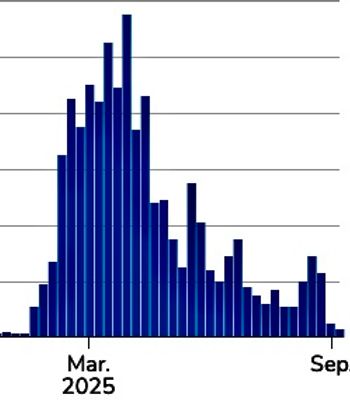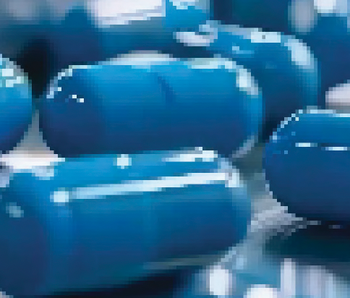
- February 2018
- Volume 3
- Issue 1
A Peculiar Finding in an Unfamiliar Patient
A rare metallo-ß-lactamase makes its way into the United States via an 84-year-old patient.
CASE: Presence of New Delhi Metallo-ß-lactamase-1 in a Female Patient
Early August 2017
- An 84-year-old woman presented to the emergency department (ED) with chief complaint of trouble breathing, lower abdominal pain, and diarrhea for 4 days.
- Afebrile, vital signs within normal limits, white blood cell (WBC) count of 8 K/µL
- Urinalysis results: positive nitrite, small leukocyte esterase, 7 to 20 WBCs per high power field
- Discharged from ED with prescription for trimethoprim/sulfamethoxazole for a urinary tract infection
Mid-August 2017
- Patient returned to ED, complaining of shortness of breath, left-sided chest pain, and a nonproductive cough.
- Urine culture from early August ED visit reviewed: Escherichia coli resistant to penicillins, cephalosporins, carbapenems, fluoroquinolones, and trimethoprim—sulfamethoxazole found; retained susceptibility to aztreonam
- Concerning for possible metallo-ß-lactamase (MBL) production
- Patient was admitted for observation because of chest pain, and a consult to the Infectious Diseases (ID) service was obtained.
- ID evaluation: Patient denied urinary complaints. No findings to support diagnosis of an acute bacterial infection; afebrile, WBC count 8.5 K/µL Repeat urine culture sent with additional testing requested Identical organism grew—susceptible to aztreonam, tigecycline, nitrofurantoin, and colistin. E-test for fosfomycin showed activity. Resistant to ceftazidime—avibactam, also consistent with MBL production Two outside laboratories confirmed the presence of the New Delhi metallo-ß-lactamase-1 (NDM-1) enzyme by polymerase chain reaction. Thorough history obtained to determine where patient may have acquired this organism Neither patient nor close contacts including family, friends, and visiting health care workers traveled internationally. Review of accessible records revealed 10 courses of antibiotics over the past 4 years. Decided to observe patient off antibiotics Plan to start fosfomycin if she developed symptoms of cystitis
PREVALENCE AND IMPACT OF CARBAPENEM RESISTANCE AND METALLO-ß-LACTAMASE—PRODUCING ORGANISMS IN THE UNITED STATES
Over the past decade, carbapenem resistance in Enterobacteriaceae has become more prevalent worldwide, and the United States has been no exception. In the latest report compiled by the CDC, there were an estimated 9300 infections caused by carbapenem-resistant Enterobacteriaceae (CRE) annually, resulting in 610 deaths.1 These data are largely driven by the Klebsiella pneumoniae carbapenemases (KPCs), which are serine-based carbapenemases that have been reported in every state of the United States except for Idaho. Metallo-ß-lactamases (MBLs), which are dependent on zinc for the hydrolysis of ß-lactams, occur more frequently in other countries, such as Greece, India, and across the Middle East.2 New Delhi metallo- β-lactamase-1 (NDM-1) is an MBL that has become widespread in India over the past decade and is rarely encountered in the United States. As of June 2017, only 230 NDM isolates had been reported in the United States, in addition to the 41 and 30 reported isolates of Verona integron—encoded metallo-β-lactamase (VIM)— and inosine-5’-monophosphate (IMP) –producing CRE, which are also MBLs. Only 3 NDM-1 isolates were reported in the state where the patient discussed was evaluated.3 These numbers likely underestimate the prevalence of MBL-producing organisms, as laboratory testing is not always accessible or optimal and there is not mandatory reporting of carbapenem resistance in every state.4
IDENTIFICATION OF CARBAPENEM RESISTANCE
Carbapenem resistance in gram-negative bacteria can be attributed to production of carbapenemases or may be the result of multiple resistance mechanisms at work—such as altered permeability of the cell wall preventing carbapenem entry, along with cephalosporinase production that would additionally confer resistance to penicillins and cephalosporins.4-6 Even when carbapenemase production is the suspected mode of resistance, multiple factors affect the ability of currently available antimicrobials to eradicate these organisms. These include the class of the carbapenemase (zinc or serine based), antibacterial minimum inhibitory concentrations, the level of expression of the gene encoding for the carbapenemase, the bacterial inoculum, and the ability to achieve adequate antibacterial concentrations to eradicate those inoculums at the site of infection.4,5
Because of the many possible mechanisms for carbapenem resistance, MBL production cannot be identified on a susceptibility panel alone. Since aztreonam is hydrolyzed by serine-based carbapenemases, such as KPC but not MBL, an organism resistant to all ß-lactams except aztreonam may raise suspicion for an MBL-producing organism. However, many MBL-producing organisms possess other modes of antibacterial resistance, including extended spectrum ß-lactamases (ESBLs) or cephalosporinases, which would confer resistance to aztreonam. Similarly, an organism resistant to ceftazidime—avibactam and meropenem–vaborbactam, which are active against many serine carbapenemase producers but not MBLs, may prompt further investigation.7 These suspicions should be confirmed by molecular testing, such as polymerase chain reaction with sequencing.7 Molecular tests may not be readily available in clinical laboratories, warranting outsourcing to other labs, increasing the time to results and, inevitably, time to appropriate treatment of patients.
TREATMENT OPTIONS FOR MBL-PRODUCING ORGANISMS
When it comes to treatment of MBL-producing organisms, the antimicrobials that are currently available are less than ideal. The agents most frequently associated with preserved activity are colistin, tigecycline, and fosfomycin.8 Their use is frequently limited by narrow therapeutic indices, intermediate susceptibility, or sources of infection where drug concentrations achieved are suboptimal. Newly approved therapies such as ceftazidime— avibactam and meropenem—vaborbactam are active only against serine carbapenemases and possess no activity against MBL producers.9
A majority of the data surrounding treatment of CREs lie in combination therapy with antibacterials from multiple classes. Most of these studies include KPC producers, with few studies evaluating treatment of MBL-producing organisms. A review of 907 patients with systemic infections, 188 of whom were infected with isolates producing the MBL VIM enzyme, demonstrated that combination therapy with 2 or more agents was superior to monotherapy and associated with a survival benefit (27.4% vs 38.7% with monotherapy; P<.001). The lowest rate of mortality (18.8%) was observed in patients who received carbapenem therapy as part of their combination regimen.10
The data on treating NDM MBLs are largely limited to case reports. Clinical success was described in a neutropenic patient on active chemotherapy with NDM-1 K. pneumoniae bacteremia was treated with polymyxin B in combination with aztreonam, until the isolate was found to be resistant to aztreonam, at which point an extended infusion of meropenem was substituted for aztreonam.11 Petersen-Morfin et al describe a burn patient who became bacteremic with a susceptible Pseudomonas aeruginosa and an NDM-1 K. pneumoniae. The patient was initiated on colistin, amikacin, and enteral rifampin and died 3 days later.12
Fosfomycin has retained activity against many MBL blood and urinary isolates in vitro, but its oral preparation is the only formulation available in the United States at this time, precluding its use in systemic infections because of suboptimal concentrations in sites other than the bladder.13 Therefore, its use, like nitrofurantoin, is largely limited to uncomplicated urinary tract infections (UTIs). The remaining cases reported in the literature on treatment of NDM isolates are of patients who were treated with oral fosfomycin or nitrofurantoin for UTIs. A pediatric patient from New Delhi who developed a UTI with NDM-1 was initiated on tigecycline for 5 days with transition to 1 dose of oral fosfomycin, which sterilized her urine.14 Rosa et al described 2 cases of NDM Enterobacteriaceae causing complicated UTIs in renal transplant patients successfully treated using the “double carbapenem” strategy plus oral fosfomycin.15,16 Both patients improved clinically, and urine cultures were sterilized. Rogers et al described treatment of 2 isolates, 1 eradicated by nitrofurantoin monotherapy, while colistin and rifampin were used for the second infection, as no oral options remained active. Both patients achieved clinical cure.17 Although aztreonam is a theoretical treatment option, as the drug is not hydrolyzed by MBLs, there is a lack of evidence utilizing aztreonam as monotherapy for infections caused by MBL-producing organisms. However, aztreonam—avibactam specifically targets MBLs and is currently being studied in phase 2 trials. When avibactam is added to aztreonam, it also restores activity against other ß-lactamases that may be expressed simultaneously, such as ESBLs or serine-based carbapenemases.4 In vitro studies demonstrate potent activity against CREs, serine carbapenemase— and MBL-producing organisms alike, with more than 98% of Enterobacteriaceae isolates being inhibited.18,19 Results from recent research have shown that using ceftazidime—avibactam paired with aztreonam may be synergistic.20,21 This novel strategy has been used with clinical success, including in 1 patient who was bacteremic for 26 days on alternative therapy but cleared cultures hours after initiation of this regimen.22,23
There are 2 more therapies targeted for MBLs in the pipeline. Cefiderocol is a siderophore cephalosporin that is stable against carbapenemases, including MBLs. In vitro, it has shown excellent activity against KPC and MBL strains, including NDM.24 LYS228 is a monobactam with activity against an array of drug-resistant organisms. In vitro, it has demonstrated potent activity against carbapenemase-producing organisms, including MBLs.25
In conclusion, evidence for treatment of infections caused by MBL-producing organisms is scarce. With each case, benefits and risks of treatment must be considered. Site of infection, source control, ability to optimally dose antimicrobials without compromising safety, and severity of illness should play a role in the decision of which antimicrobials to initiate. The clinical successes described in the limited available evidence may be multifactorial and should be interpreted carefully. An important consideration when evaluating this literature is that it may be confounded by the fact that acquisition of resistance genes frequently comes at a fitness cost for organisms, which may make them less virulent.26 There is great anticipation for newer agents in the pipeline that are specifically targeted for MBLs.
Special thanks to the Maryland Department of Health and the lab of Barry Kreiswirth, PhD, at the Public Health Research Institute Center at Rutgers Medical School for testing the isolate via polymerase chain reaction to detect the NDM-1 enzyme.
Dr. Terico is an infectious diseases clinical pharmacy specialist practicing in Philadelphia, Pennsylvania. She is a graduate of Temple University School of Pharmacy and completed 2 years of post-graduate training at Temple University Hospital. She is an active member of SIDP.
Dr. Pace graduated from Temple University School of Medicine, Philadelphia, Pennsylvania. He completed a residency in internal medicine at Temple University Hospital and a fellowship in infectious disease at Hahnemann University Hospital, also Philadelphia. Dr. Pace is board-certified in internal medicine and infectious disease.
References:
- CDC. Antibiotic resistance threats in the United States, 2013. cdc.gov/drugresistance/threat-report-2013/pdf/ar-threats-2013-508.pdf. Accessed December 6, 2017.
- Tängdén T, Giske CG. Global dissemination of extensively drug-resistant carbapenemase-producing Enterobacteriaceae: clinical perspectives on detection, treatment and infection control. J Intern Med. 2015;277(5):501-512. doi: 10.1111/joim.12342.
- Healthcare-associated infections: tracking CRE. CDC website. cdc.gov/hai/organisms/cre/trackingcre.html. Updated November 2017. Accessed December 6, 2017.
- Bonomo RA, Burd EM, Conly J, et al. Carbapenemase-producing organisms: a global scourge! [published October 16, 2017]. Clin Infect Dis. doi: 10.1093/cid/cix893.
- Queenan AM, Bush K. Carbapenemases: the versatile beta-lactamases. Clin Microbiol Rev. 2007;20(3):440-458. doi: 10.1128/CMR.00001-07.
- Bidenbach D, Bouchillon S, Hackel M, et al. Dissemination of NDM metallo-β-lactamase genes among clinical isolates of Enterobacteriaceae collected during the SMART global surveillance study from 2008 to 2012. Antimicrob Agents Chemother. 2015;59(2):826-830. doi: 10.1128/AAC.03938-14.
- Wei WJ, Yang HF, Ye Y, Li JB. New Delhi metallo-β-lactamase-mediated carbapenem resistance: origin, diagnosis, treatment and public health concern. Chin Med J (Engl). 2015;128(14):1969-1976. doi: 10.4103/0366-6999.160566.
- Chibabhai V, Nana T, Bosman N, Thomas T, Lowman W. Were all carbapenemases created equal? Treatment of NDM-producing extensively drug-resistant Enterobacteriaceae: a case report and literature review [published September 15, 2017]. Infection. doi: 10.1007/s15010-017-1070-8.
- Wright H, Bonomo RA, Paterson DL. New agents for the treatment of infections with gram-negative bacteria: restoring the miracle or false dawn? Clin Microbiol Infect. 2017;23(10):704-712. doi: 10.1016/j.cmi.2017.09.001.
- Tzouvelekis LS, Markogiannakis A, Piperaki E, Souli M, Daikos GL. Treating infections caused by carbapenemase-producing Enterobacteriaceae. Clin Microbiol Infect. 2014;20(9):862-872. doi:10.1111/1469-0691.12697.
- Chien JMF, Koh TH, Chan KS, Chuah TH, Tan TT. Successful treatment of NDM-1 Klebsiella pneumoniae bacteremia in a neutropenic patient. Scand J Infect Dis, 2012; 44(4):312-314. doi: 10.3109/00365548.2011.633549.
- Petersen-Morfin S, Bocanegra-Ibarias P, Morfin-Otero R, et al. New Delhi Metallo-beta-lactamase (NDM-1)- producing Klebsiella pneumoniae isolated from a burned patient. Am J Case Rep. 2017;18:805-809. doi: 10.12659/AJCR.903992.
- Demir T, Buyukguclu T. Fosfomycin: in vitro efficacy against multidrug-resistant isolates beyond urinary isolates. J Glob Antimicrob Resist. 2017;8:164-168. doi: 10.1016/j.jgar.2016.11.011.
- Green DA, Srinivas N, Watz N, et al. A pediatric case of New Delhi Metallo-β-lactamase-1-producing Enterobacteriaceae in the United States. Pediatr Infect Dis J. 2013;32(11):1291-1294. doi: 10.1097/INF.0b013e31829eca34.
- Bulik CC, Nicolau DP. Double-carbapenem therapy for carbapenemase-producing Klebsiella pneumoniae. Antimicrob Agents Chemother. 2011;55(6):3002-3004. doi: 10.1128/AAC.01420-10.
- Rosa R, Rudin SD, Rojas LJ, et al. “Double carbapenem” and oral fosfomycin for the treatment of complicated urinary tract infections caused by blaNDM-harboring Enterobacteriaceae in kidney transplantation [published October 24, 2017]. Transpl Infect Dis. doi: 10.1111/tid.12795.
- Rogers BA, Sidjabat HE, Silvey A, et al. Treatment options for New Delhi Metallo-beta-lactamase-harboring Enterobacteriaceae. Microb Drug Resist. 2013;19(2):100-103. doi: 10.1089/mdr.2012.0063.
- Karlowsky JA, Kazmierczak KM, de Jonge BLM, et al. In vitro activity of aztreonam-avibactam against Enterobacteriaceae and Pseudomonas aeruginosa isolated by clinical laboratories in 40 countries from 2012 to 2015. Antimicrob Agents Chemother. 2017;61(9):e00472-17. doi: 10.1128/AAC.00472-17.
- Vasoo S, Cunningham SA, Cole NC, et al. In vitro activities of ceftazidime-avibactam, aztreonam-avibactam, and a panel of older and contemporary antimicrobial agents against carbapenemase-producing gram-negative bacilli. Antimicrob Agents Chemother. 2015;59(12):7842-7846. doi: 10.1128/AAC.02019-15.
- Marshall S, Hujer AM, Rojas LJ, et al. Can ceftazidime-avibactam and aztreonam overcome β-lactam resistance conferred by metallo-β-lactamases in Enterobacteriaceae? Antimicrob Agents Chemother. 2017:61(4):e02243-16. doi: 10.1128/AAC.02243-16.
- Wenzler E, Deraedt MF, Harrington AT, Danizger LH. Synergistic activity of ceftazidime-avibactam and aztreonam against serine and metallo-β-lactamase-producing gram-negative pathogens. Diagn Microbiol Infect Dis. 2017(88):352-354. doi: 10.1016/j.diagmicrobio.2017.05.009.
- Davido B, Fellous L, Lawrence C, Maxime V, Rottman M, Dinh A. Ceftazidime-avibactam and aztreonam, an interesting strategy to overcome β-lactam resistance conferred by metallo-β-lactamases in Enterobacteriaceae and Pseudomonas aeruginosa. Antimicrob Agents Chemother. 2017;61(9):e01008-17. doi: 10.1128/AAC.01008-17.
- Mojica MF, Ouellette CP, Leber A, et al. Successful treatment of bloodstream infection due to metallo-β-lactamase-producing Stenotrophomonas maltophilia in a renal transplant patient. Antimicrob Agents Chemother. 2016;60(9):5130-5134. doi: 10.1128/AAC.00264-16.
- Kohira N, West J, Ito A, et al. In vitro antimicrobial activity of a siderophore cephalosporin, S-649266, against Enterobacteriaceae clinical isolates, including carbapenem-resistant strains. Antimicrob Agents Chemother. 2016;60(2):729-734. doi: 10.1128/AAC.01695-15.
- Mendes R, Rhomberg PR, Schaefer B, et al. In vitro activity of LYS228 against Enterobacteriaceae, including molecularly characterized multidrug-resistant isolates. Presented June 3, 2017 at: American Society of Microbiology Meeting 2017; New Orleans, LA. Abstract 293.
- Schulz zur Wiesch P, Engelstädter J, Bonhoeffer S. Compensation of fitness costs and reversibility of antibiotic resistance mutations. Antimicrob Agents Chemother. 2010;54(5):2085-2095. doi:10.1128/AAC.01460-09.
Articles in this issue
almost 7 years ago
Staying Ahead of the Curve: Implementing AUC-Guided Vancomycin Dosingalmost 7 years ago
Undetectable Equals Untransmittablealmost 7 years ago
Omadacycline: A New Player for Team Tetracyclinealmost 8 years ago
A New Year, A New Lead, and New Offerings to Comealmost 8 years ago
Successful Stewardship Strategies in Long-Term Care Facilitiesalmost 8 years ago
5 Emerging Infections to Watch Out For in 2018Newsletter
Stay ahead of emerging infectious disease threats with expert insights and breaking research. Subscribe now to get updates delivered straight to your inbox.



















































































































































































































































































